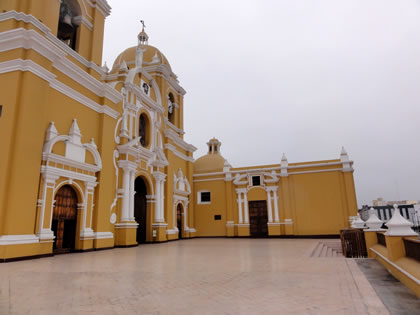MUSEO CATEDRALICIO
I was walking under a blazing sun towards the Cathedral when three buses parked near us and then it began a varied parade of tourists, who crammed the sidewalk. This situation caught my attention and reminded me what it's like to be a tourist: This mixture of confusion and excitement when you make the first step and prepare your camera to capture the first thing that comes your way. I wanted to talk to them, offered them my help and be a good host, but I suddenly remembered that I had a mission to accomplish, so I headed to my destination. The idea of the catacombs cheered me up again.
At the door, after a security cordon, we find Mr. Genaro Barr, the manager of the museum, who received us kindly and answered our questions. The place was a little bit dark, which gave it a hint of mystery. "This was the place where the tithes were collected," he said. ¿Tithe? I asked. "Yes, all the people of that time, mostly Catholics, donated 10% of their income to the church". This house was a window to our colonial history. It was now a museum with a French organ (Melody, 1857), priest accessories were on display cases and some others were outdoors, there was also a restoration workshop. On the walls there were original replicas of famous paintings made anonymously, such as La Institución de la Eucaristía.
Near a painting of Christ's Passion there were three saint sculptures that really scared me, especially the woman’s face of the middle that with her black eyes showed a strange mixture between sadness and mercy, she was feeling sorry for what I would experience when I will go into the vault.
Behind us, an underground entrance was waiting for us.
We asked the Mr. Genaro where the stairs who were behind the organ led. He said that "underneath is the vault", the place where they buried the brotherhood in colonial times. The idea that below the museum were buried human remains paralyzed me, and I began to feel a strange sensation that my face revealed. To my relief, Genaro said that all the remains and tombs were relocated.
I descended the 17 wooden steps and the stuffy air hit my face. Before me there were damp tunnels, as if this was horror movie. The area was filled with statues of saints with unfriendly faces that contrasted with the women at the top.
The paintings on the walls were equally sinister: An angel beheaded with the naked torso, a woman with a sorrowful face. Each seemed to portray each person who had been buried there. At the end of the longest tunnel there was a huge medallion of Jesus Christ, a little bigger than an adult and slightly rusty around the edges and at the center. I tried to get to the medallion, but the air was so heavy that my head started to spin and I had to leave the place immediately.
I told Mr. Genaro what I had felt. He assured me that most tourists have similar sensations or even worse than mine. Some of them hear voices or faint especially at peak times (9:00 am, 6:00 pm). "I, for example, every time I descend I hear screams, but it's been so long that I’m used to it," he told us.
I thanked him that he told me this after we went down to the vault and not before, otherwise I might have never gone down. This way I ended the path through the Cathedral Museum, a good place for people who want to experience an unconventional museum.























0 comments:
Post a Comment